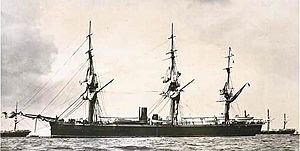HMS Rover (1874) facts for kids

HMS Rover
|
|
Quick facts for kids Class overview |
|
|---|---|
| Name: | HMS Rover |
| Operators: | |
| Preceded by: | Amethyst class |
| Succeeded by: | Emerald class |
| Built: | 1872–1874 |
| In commission: | 1874–89 |
| Completed: | 1 |
| Scrapped: | 1 |
| History | |
| Builder | Thames Ironworks and Shipbuilding Company, Leamouth, London |
| Cost | £169,739 |
| Laid down | 1872 |
| Launched | 12 August 1874 |
| Completed | 21 September 1875 |
| Fate | Sold for scrap, 1893 |
| General characteristics (as built) | |
| Type | Iron screw corvette |
| Displacement | 3,462 long tons (3,518 t) |
| Length | 208 ft (63.4 m) pp |
| Beam | 43 ft 6 in (13.3 m) |
| Draught |
|
| Depth of hold | 23 ft (7.01 m) |
| Installed power | 4,964 ihp (3,702 kW) |
| Propulsion |
|
| Sail plan | Ship rig |
| Speed |
|
| Range | 1,840 nmi (3,410 km; 2,120 mi) at 10 knots (19 km/h; 12 mph) |
| Complement | 315 |
| Armament |
|
HMS Rover was a special warship built for the Royal Navy in the 1870s. She was an 18-gun iron screw corvette, which means she was a fast, medium-sized warship. Rover was the only ship of her kind ever built. She served in different parts of the world, like the North America and West Indies Station. Later, she became a training ship, but she wasn't quite right for that job. Rover was eventually sold for scrap in 1893.
Contents
Building HMS Rover
HMS Rover was designed in 1872 by Edward James Reed. He was the Navy's main ship designer at the time. Rover was an improved version of earlier ships called the Volage-class corvettes.
Size and Structure
Rover was a large ship for her time. She weighed about 3,462 tons. She was about 280 feet (85.3 meters) long. Her widest part, called the beam, was 43 feet 6 inches (13.3 meters).
The ship's hull was made of iron. It was covered with a 3-inch (7.6 cm) layer of oak wood. This wood was then covered with zinc below the waterline. This helped stop sea creatures from growing on the hull. The inside of the ship had strong walls called bulkheads. These divided the hull into watertight sections. This made the ship safer. A crew of 315 officers and sailors worked on board.
Engine and Speed
Rover had one powerful steam engine. It was a three-cylinder engine made by Ravenhill, Eastons & Co. This engine turned a single propeller that was 21 feet (6.4 meters) wide. Ten large boilers created steam for the engine.
The engine gave Rover a top speed of 14.5 knots. A knot is a way to measure speed at sea. The ship could carry 420 tons of coal. This was enough fuel to travel 1,840 nautical miles at a speed of 10 knots.
Sails and Performance
Even with her powerful engine, Rover also had sails. She was a ship rigged vessel. This means she had three masts with square sails. Her total sail area was about 17,863 square feet (1,660 square meters).
However, Rover was not very good at sailing. Her best speed using only sails was 11 knots. One reason for this was how the ship sat in the water. Her front and back parts were not evenly balanced. To help with sailing, her propeller could be lifted out of the water. This reduced drag and made her sail a little better.
Ship's Guns
When first built, Rover had two types of guns.
- Two 7-inch (17.8 cm) rifled muzzle-loading guns. These were placed at the front and back of the ship. They were used as chase guns, meaning they could fire straight ahead or behind.
- Sixteen 6.3-inch (16 cm) 64-pounder rifled muzzle-loading guns. These were placed along the sides of the ship. They fired sideways in what was called a broadside.
In 1880, the ship's guns were updated. She received 14 new breech-loading guns. These were 6-inch (15.2 cm) 80-pounder guns. Again, one gun was at the bow (front) and one at the stern (back). The rest were on the sides. The ship also got two special launchers for 14-inch (35.6 cm) torpedoes.
Construction Details
Rover was built at the Thames Ironworks and Shipbuilding Company. This shipyard was in Leamouth, London. Work on the ship began in 1872. She was officially launched into the water on August 12, 1874. The ship was fully finished and ready for service on September 21, 1875. Her total cost was £169,739.
HMS Rover's Service
Rover began her service with the North America and West Indies Station. This means she was sent to patrol the waters around North America and the Caribbean. During this time, she was slightly damaged when she accidentally ran aground.
In 1879, Rover returned home to England. She went to Chatham Dockyard for repairs and updates. After this, she was kept in reserve. This means she was ready to be used if needed, but not actively sailing.
In 1885, Rover joined the Training Squadron. This was a group of ships used to train new sailors. However, Rover was not the best ship for this job. Her poor sailing performance made her less suitable for training under sail. Because of this, she was taken out of service in 1889. She was then sold for scrap in 1893.
A famous person who served on Rover was Robert Falcon Scott. He was a well-known Antarctic explorer. He spent nine months aboard Rover starting in late 1886.

